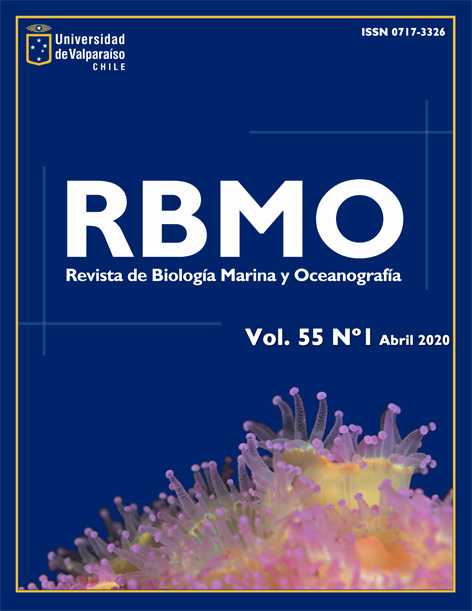Temporal and vertical variability of bacterioplankton composition in Chipana bay (21º20’S) in a coastal upwelling system of northern Chile: A fluorescence in situ hybridization approach
DOI:
https://doi.org/10.22370/rbmo.2020.55.1.2375Keywords:
Hybridization in situ, bacteria, archaea, upwelling systems, ChileAbstract
The bacterioplankton in the upwelling systems associated with oceanographic condition of the oxygen minimum zone (OMZ) of the Eastern tropical South Pacific was studied through visualization and enumeration with fluorescent in situ hybridization (FISH). Six different taxonomic groups were studied (Alpha, Beta, Gamma-proteobacteria, Cytophaga-flavobacterium and the domains Archaea and Bacteria). The analysis showed a greater predominance of the Bacteria domain (20 to 68% of hybridized cells) over Archaea (2 to 18% of hybridized cells). The specific groups showed that Cytophaga-flavobacterium, Alpha-proteobacteria and Gamma-proteobacteria are more abundant in the surface layer. Gamma-proteobacteria is also most abundant in the deep oxycline and, Beta-proteobacteria is the group with the lowest registered abundances. Changes in the vertical distribution of the bacterial community in the water column between OMZ and on oxycline were observed through NMDS. This change is a product of a shift in the abundances of the specific groups Cytophaga-flavobacterium and Gamma-proteobacteria in the surface layers, due to low concentration of chlorophyll-a caused by periods of relaxation in the upwelling.
Downloads
Published
How to Cite
Issue
Section
License
• Los autores que publican en la RBMO transfieren sus derechos de publicación a la Universidad de Valparaíso, conservando los derechos de propiedad intelectual para difundir ampliamente el artículo y la revista en cualquier formato.
• La RBMO autoriza el uso de figuras, tablas y extractos breves de su colección de manuscritos, en trabajos científicos y educacionales, siempre que se incluya la fuente de información.





